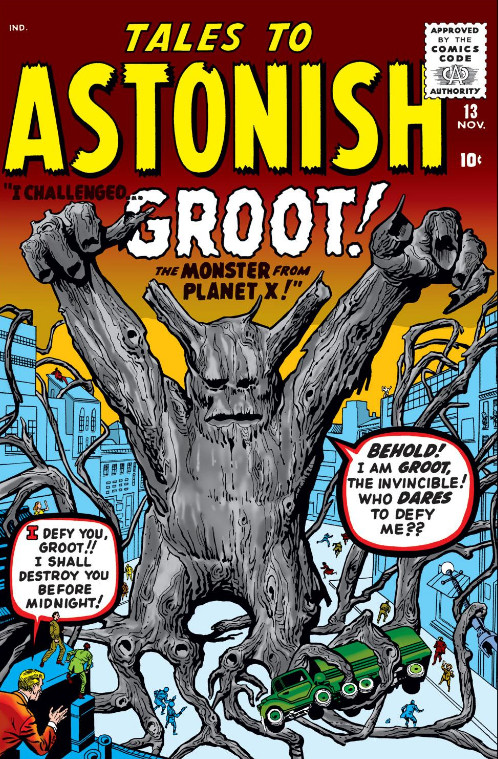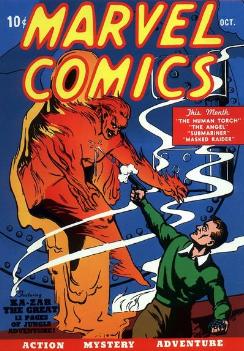 |
| The first meeting of the Silver Age Flash and the Golden Age Flash in 1961--the beginning of the DC multiverse. |
One of the things that always puzzled me is how Marvel Comics rose to popularity so quickly in the early 1960s. Sure, I had read some reprints of the early Marvel comics, and I already had developed a soft spot for Kirby and Ditko thanks to their work at DC in the 70s, like Omac and Shade, but frankly, the early Marvel stuff just seemed rather crude and undeveloped to me.
 |
| Jack Kirby's Omac. One of my favorite comic series |
 | |
| Steve Ditko's Shade. Another of my favorite comic series |
 |
| Aquaman #1 from 1962. "Thrilling" is not a word that I would use for the story. |
Marvel came along with the Fantastic Four, Spider-Man, The Hulk, Thor, Iron Man, the revived Captain America, etc, and while the stories and art were a bit crude, (Kirby and Ditko had yet to reach their artistic peaks at this point), they were exciting, and full of action, as the heroes went head-to-head against powerful villains, not knowing if they would be able to defeat them. Furthermore, the heroes had more realistic problems that they weren't sure they could overcome, not silly soap-opera problems. The Fantastic Four fought amongs themselves, Spider-Man was a troubled teen wanted by the police, Iron Man had to always worry about his chest-plate and protecting his heart, Bruce Banner couldn't control what he did as the Hulk, and usually couldn't control when he became the Hulk, etc.
Given the context of what was going on at DC, it becomes obvious why Marvel became popular. Not that there weren't *some* bright spots at DC. The new versions of the Flash and Green Lantern were both interesting and enjoyable, and The Doom Patrol were an interesting and unusual superhero group, for example.
 |
| My Greatest Adventure #80 (1963) - Introducing The Doom Patrol, the World's Strangest Heroes. |
Furthermore, the rise of Marvel gave DC a jolt, and throughout the 60s, DC tried different things to keep up with their competition, although what finally worked for DC was simply getting new, younger writers and artists in the late 60s and early 70s. Plus, the Marvel formula was getting overworked and overextended by the late 60s, and the initial excitement they generated just wasn't sustainable.
Another interesting point is how Marvel's, or rather Atlas', monster and alien stories fed into their superhero foray. Atlas? You see, Marvel wasn't really a new company in the early 60's, that was just their latest company name. They were originally Timely Comics back in the 40s, changed to Atlas Comics in the 50s, and became Marvel Comics in the 60s. Stan Lee was no newcomer, either, as he had started with them back when they were Timely, and thus was quite familiar with superheroes.
When Superman appeared in 1938, it started an explosion of superheroes and superhero comics. There were several comic book companies in the 1940s, and they all had their superheroes among their other comics. However, as the 1940s went on, superheroes seemed to be a dying trend. Most superhero titles were cancelled, and the surviving comic book companies continued by publishing various genre comics: westerns, romances, teen, funny animals, crime, horror, etc. It was the crime and horror comics that especially disturbed Dr. Fredric Wertham, and which led to Congressional investigations and the development of the Comics Code Authority, a self-policing group within the comics industry.
 |
| Strange Tales #28 from 1954 - An especially scary cover pre-Comics Code Authority. Notice the Atlas logo. |
Ironically, it may have been thanks to Wertham and the Comics Code that superheroes made a comeback. With the restrictions put upon comics, the crime and horror comics had trouble sustaining their popularity, and a return to superheroes allowed the comics companies to do something interesting and exciting while still staying within the limits of the code. Superheroes could fight supervillains with stylized violence that didn't call for blood and gore. However, DC didn't merely revive the Golden Age versions of Flash and Green Lantern, but created new versions of them. When these did well, DC created the Justice League of America, a new superhero group, instead of trying to revive the Golden Age group Justice Society of America.
 |
| The first appearance of the JLA in The Brave and the Bold #28 (1960). Superman and Batman were also part of the team, but de-emphasized for some reason. |
It was the popularity of the JLA that led Martin Goodman, publisher at Atlas/Marvel, to ask Stan Lee to come up with a version of the Justice League. Instead, Stan and Jack Kirby created The Fantastic Four, and thus began the Marvel Age of Heroes.
Atlas, like the other publishers of the time, was publishing genre material like westerns, romance, and humor comics. But because of Wertham and the Comics Code Authority, they had switched from doing straight horror and crime stories to stories mostly involving monsters and aliens. They did a LOT of monster and alien stories. So when Goodman wanted them to switch to superheroes, it was like they carried that monster and alien sensibility over to their superhero stories.
 |
| An early Tales to Astonish issue, Groot is both a monster and an alien! But still approved by the Comics Code Authority. |
The early Fanstastic Four shows this monster and alien sensibility. The Fantastic Four were less like the Justice League and more like the Challengers of the Unknown, a title Jack Kirby had created for DC a few years before, but the FF had superpowers, whereas the Challengers were ordinary humans. The FF's earliest foes were monsters and aliens; one of their members, the Thing, was for all intents and purposes, a monster, although he fought against bad guys. They didn't even have costumes until the third issue.
 |
| Fantastic Four #1 - No costumes as they fight a monster from the underground. |
This monster and alien sensibility wasn't so strongly felt in other titles, but it was there. Spider-Man runs into his share of monsters and aliens, too. Thor's first Marvel appearance involved an alien invasion. The Hulk was himself a monster, moreso than the Thing, because you couldn't be sure if he would do good or evil. And even the Hulk encountered aliens early in his publishing history.
 |
| The Hulk fights the alien Toad Men in his second issue, 1962. |
But eventually, Marvel developed a more superhero sensibility, although monsters and aliens never completely left. Once they had established enough superheroes, they even came up with their own version of the Justice League with the Avengers title.
 |
| Avengers #1 - Okay, they're fighting Loki, a Norse God, but technically he's still an alien to Earth! |
But I still consider myself more of a DC fan than a Marvel Fan. Sorry Stan!

No comments:
Post a Comment